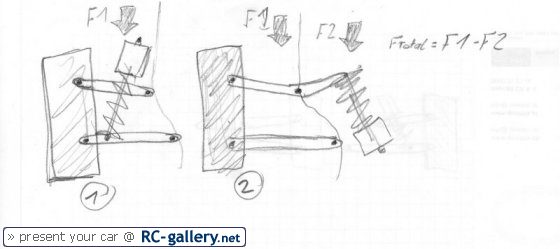|
| Site Partners: | SpotterGuides | Veloce Books |
| Related Sites: | Your Link Here |
|
||||||||||
|
||||||||||
|
|
#1 | |
|
Rookie
Join Date: Jul 2009
Posts: 5
 |
Unsprung Mass
Hi all
If I put the damper (for example) from somewhere between the Wheel and the inner Joint of the suspension arr to the middle of the car (on the oher side of the joint). Will this reduce the Unsprung weight and does it improve/affect the handling of a car? I hope you understood my English  Dave |
|
|
|

|
|
|
#2 | |||
|
Rookie
Join Date: Dec 2007
Posts: 20
 |
Quote:
 But I don´t get what do you want to do. Can you scketch a drawing of what do you have, and what would be the change? |
|||
|
|

|
|
|
#3 | ||
|
Rookie
Join Date: Jan 2009
Posts: 13
 |
I think he is talking about pushrod suspension
|
||
|
|

|
|
|
#4 | |
|
Rookie
Join Date: Jul 2009
Posts: 5
 |
Ok, next try...
What I mean is: In sketch 1, the complete unsprung mass is on the left side of the Suspension arm pivots. In sketch 2, there is a bit of weight on the right side of the pivots. Probably the whole unsprung weight is the same, but the force to raise the wheel should be less in sketch 2. I believe sketch 2 will works better on bumps. Or am I completly wrong? 
|
|
|
|

|
|
|
#5 | |
|
Veteran
Join Date: Jul 2005
Posts: 1,981
  |
You will reduce unsprung weight - but not by very much. In fact by less than half of the coilover weight.
For a start, only half the damper/spring weight is considered to be acting on the lower arm. The other half is 'sprung weight' as it is suspended from the chassis. In terms of wheel rate, because the coilover is mounted some way up the lower link, again only part of the weight is seen at the wheel, and the rest is carried by the in-board lower joint to the chassis, so that part can be considered sprung weight also. Overall, unless your coilovers are very heavy compared to the rest of the unsprung weight - hubs, brakes, wheels and tyres plus half the weight of the wishbones - I wouldn't think that the handling would be noticeably improved, though I could be wrong! |
|
|
|

|
|
|
#6 | ||
|
Veteran
Join Date: Apr 2006
Posts: 1,943
 |
I would agree with that.
The way I see it is real benefits are by having a lever ratio and there by making the damper smaller, and with placement and packaging for Aero sensitive applications |
||
|
|
__________________
Contrary to popular opinion, I do have mechanical sympathy, I always feel sorry for the cars I drive. 
|
|
|
#7 | ||
|
Rookie
Join Date: Jun 2009
Posts: 9
 |
If drawing No 2 uses a lighter damper and spring then the unsprung weight will be less. The way to find out is to see what moves with the suspension, then weigh it. You will not go wrong doing that. The lighter the car, the more benefit will be gained by reducing unsprung weight.
All the best, Alex. |
||
|
|

|
|
|
#8 | |||
|
Rookie
Join Date: Dec 2007
Posts: 20
 |
Quote:
The second design is usually better for the aero, but needs a much stiffer upper arm (which could finally increase the sprung mass). Its bending stiffness is critical with that kind of design, as it will have big implications on wheel rate (it will be in series with the ride spring) That´s why "rocker arm" suspension (as in your drawing) have been replaced by pushrod/pullrod suspensions in light formulas. |
|||
|
|

|
 |
|
|
 Similar Threads
Similar Threads
|
||||
| Thread | Thread Starter | Forum | Replies | Last Post |
| Mass Dampers - your view | nickyf1 | Formula One | 28 | 23 Aug 2006 17:43 |
| Mass Dampers (merged) | Adam43 | Formula One | 116 | 5 Aug 2006 17:35 |
| engine mass | THR | Racing Technology | 29 | 28 Sep 2005 15:29 |
| Dual Mass Flywheels | graham blackwell | Racing Technology | 4 | 24 May 2005 19:10 |
| Why the mass defection....? | KC | Formula One | 8 | 14 Jan 2001 17:11 |